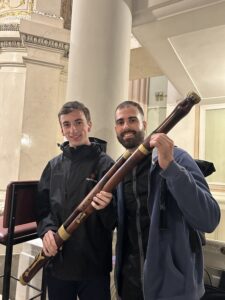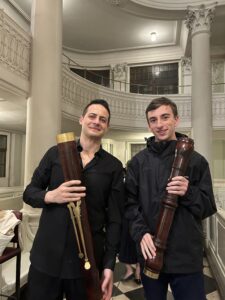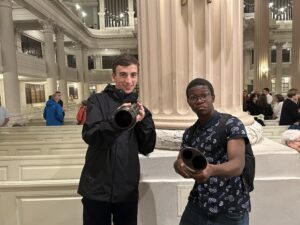Here are images of us holding random parts of the instruments (since they had already packed them up).
Me with the 2 bassoonists:


Me and Malcom (thank you Malcom for forcing me to socialize):

Going to see the St. John Passion performed in its entirety was an incredible experience. Of course, our seats weren’t ideal spots to view the orchestra, but one of the first things I saw when we got there after the orchestra came out was some kind of bassoon, that even from a distance I could see was not a standard bassoon used today. And then I saw that there were 2 different kinds of bassoons on stage! I figured they were both some kind of a baroque bassoon. I later found out one was a baroque bassoon, and the other a baroque contrabassoon! During the performance, it was difficult to hear them, but I could hear the low rattle of the contra, which added a lot to the feel of the piece.
After the performance, I stayed behind with Malcom in the hopes of getting the chance to see the bassoons up close. As a bassoonist, I own both a regular bassoon and contrabassoon, but I had never seen baroque versions of the instruments played live. We walked up to the stage to meet the bassoonists (credit to Malcom for forcing me to get over my unreasonably large sense of social anxiety…), and I was amazed at what I got to see. We talked to the bassoonists for a bit, I told them I was a bassoonist and had always wanted to see a baroque bassoon, and they showed me what the instruments looked like. It was fascinating, seeing how they differed from a regular bassoon. The bassoons we know today are extremely complicated, with a very large number of keys, 13 being for the thumbs alone. However, not only did the baroque bassoons have very few keys, and it seemed like there were more holes than keys, but the few keys they did have seemed to be very different from what you would see on a standard bassoon. I hope to one day be able to play one for myself and figure out the exact differences, because it is very interesting to me to see how the form of the instrument has changed through the years. I am curious to learn about the ranges too; a modern bassoon has a range of 3.5 octaves, and contra has a similar range. I wonder if it is possible to have a range that wide with so few keys, or if the repertoire for baroque bassoons is more limited in that sense. I am also curious about the shape of the instruments. It seemed like some parts of the baroque bassoons were more spherical, while the parts of a regular bassoon shaped more like cylinders. Does this affect the range of the instrument? Or the tone? Why has this part of the design changed over time?
Overall, I really enjoyed getting the opportunity to meet the bassoonists, and I learned a lot in that very short time. Someday, I hope to be able to play a baroque bassoon myself, and get answers to all these questions that came up just from seeing the bassoons up close.
Lastly, random flex: I followed both bassoonists on Instagram afterwards, and they both followed me back 😀